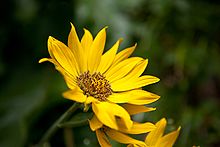- Balsamorhiza sagittata
-
Balsamorhiza sagittata 
Scientific classification Kingdom: Plantae (unranked): Angiosperms (unranked): Eudicots (unranked): Asterids Order: Asterales Family: Asteraceae Tribe: Heliantheae Genus: Balsamorhiza Species: B. sagittata Binomial name Balsamorhiza sagittata
(Pursh) Nutt.Balsamorhiza sagittata is a species of flowering plant in the sunflower tribe of the plant family Asteraceae known by the common name arrowleaf balsamroot. It is native to much of western North America from British Columbia to California to the Dakotas, where it grows in many types of habitat from mountain forests to grassland to desert scrub. It is drought tolerant.
Contents
Description
This is a taprooted perennial herb growing a hairy, glandular stem 20 to 60 centimeters tall. The branching, barky root may extend over two meters deep into the soil. The basal leaves are generally triangular in shape and are large, approaching 50 centimeters in maximum length. Leaves farther up the stem are linear to narrowly oval in shape and smaller. The leaves have untoothed edges and are coated in fine to rough hairs, especially on the undersides.
The inflorescence bears one or more flower heads. Each head has a center of long yellowish tubular disc florets and a fringe of bright yellow ray florets, each up to 4 centimeters long. The fruit is a hairless achene about 8 millimeters long. Grazing animals find the plant palatable, especially the flowers and developing seed heads.[1]
Uses
Many Native American groups, including the Nez Perce, Kootenai, Cheyenne, and Salish, utilized the plant as a food and medicine.[1]
Under the name Okanagan Sunflower, it is the official flower emblem of the city of Kelowna, British Columbia, Canada.
References
External links
 Media related to Balsamorhiza sagittata at Wikimedia Commons
Media related to Balsamorhiza sagittata at Wikimedia Commons- Jepson Manual Treatment
- USDA Plants Profile
- Flora of North America
- Photo gallery
- Edibility: Identification and edible parts of Balsamorhiza sagittata.
- [1] City of Kelowna

This Heliantheae article is a stub. You can help Wikipedia by expanding it.

